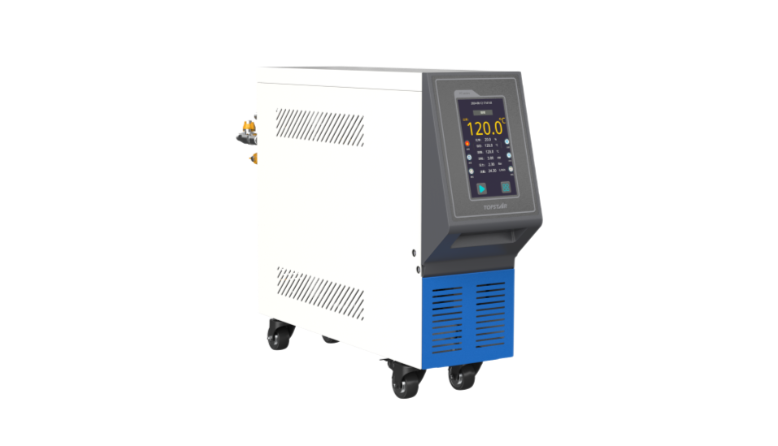Achieving precise temperature control by fixing the mould temperature controller?

Faulty mould temperature controller can lead to inconsistent product quality, longer cycle times, and increased energy costs. The most common problems include temperature fluctuations, pump failures, heating element problems, and inaccurate sensors. You may notice that the mould is not reaching the target temperature or that the unit displays error codes such as “overheat” or “low flow.” Electrical connections often loosen over time, causing intermittent operation, while mineral deposits in water cooling systems can clog internal passages. Topstar technicians have found that approximately 60% of controller repairs require simple fixes, such as recalibration or cleaning, while 30% require component replacement. The remaining 10% typically stems from complex control board issues that need professional attention.
Basic Safety Checks Before Repairing a Mould Temperature Controller
When repairing a mould temperature controller, safety always comes first. First, disconnect all power (including power and heat sources). Allow the unit to cool completely; heated chambers can remain dangerously hot for long periods after being turned off. Wear insulated gloves when handling electrical components and use a multimeter to confirm that circuits are de-energized. Check for water or oil leaks that could pose an electrical hazard. Topstar’s repair regimen emphasizes checking power cords for wear and ensuring proper grounding. For water-based systems, drain all fluids to prevent spills during disassembly. Keep a Class C fire extinguisher nearby when working on heating elements. These precautions protect technicians and equipment during repairs.
Step-by-Step Diagnostic Process for Mould Temperature Controllers
Systematic troubleshooting saves time during mould temperature controllers repair. Start by checking the basics: power supply, fuses, and circuit breakers. Monitor temperature readings with a separate calibrated thermometer to identify sensor differences. Listen for unusual pump noises, which indicate bearing wear or cavitation. Topstar’s diagnostic process recommends testing heating element continuity (typically 5-50 ohm resistance) and checking relays for proper switching. Check all wiring connections for corrosion or looseness. For PID controllers, record current tuning parameters before making adjustments. A systematic approach effectively isolates the problem—whether it’s a faulty solid-state relay (SSR), a clogged filter, or an aged thermocouple.
Cleaning and Maintenance Tips for Optimal Performance
Regular maintenance prevents most mould temperature controller failures. For water-cooled controllers, flush the system yearly to remove scale and biological growth. Use a weak acid solution to remove mineral deposits, followed by a neutralization flush. Air-cooled controllers require compressed air to clean the heat sink and fan. Topstar’s maintenance checklist includes lubricating pump bearings, replacing old thermal paste on heating elements, and cleaning electrical contacts with dielectric grease. Pay special attention to thermal oils – deteriorated oils reduce viscosity and thermal performance. Regularly inspect insulation and replace cracked or compressed parts for controllers handling high-temperature materials (>300°C). These procedures can significantly restore efficiency and extend the life of the equipment.
Replacing Critical Components
Wear on some mould temperature controller parts is to be expected. Heating elements typically have a service life of 2-5 years, depending on the period of use. Always ensure that the power and voltage specifications match when replacing heating elements. Circulation pumps typically require new seals or impellers after 10,000 hours of operation. Topstar technicians recommend upgrading to magnetic drive pumps when replacing older mechanical seals. Temperature sensors require regular recalibration or replacement – a temperature difference of 2°C can damage the precision moulding. For electronic component repairs, use OEM replacement circuit boards, not aftermarket products, to ensure compatibility. Always record component serial numbers and installation dates to establish a maintenance history. High-quality replacement parts prevent the recurrence of problems and maintain temperature stability.
Implement preventive measures to ensure long-term reliability.
Take a proactive strategy to protect your mould temperature controller investment. Install an inlet filter (minimum 100 mesh) to prevent particle contamination. Use a water treatment system to control mineral content in the cooling circuit. Topstar’s reliability program recommends quarterly infrared scans to detect hot spots before electrical components fail. Maintain a spare parts inventory for critical components such as fuses, relays, and sensors. Train operators to recognize early warning signs such as unusual noises or slow response times. Consider retrofitting older equipment with modern PID controllers to improve temperature stability. These measures can reduce unplanned downtime by up to 80% while maintaining a temperature control accuracy of ±0.5°C.
Improve control accuracy through repair and maintenance.
Repairing and maintaining mould temperature controllers directly affect product consistency and operational efficiency. By understanding standard failure modes, following safety procedures, and implementing systematic maintenance, manufacturers can achieve reliable ±1°C temperature control. Topstar’s field data shows that a well-maintained controller can last 7-10 years, while a poorly maintained controller can last only 3-5 years. Remember that in precision moulding applications, accurate temperature regulation can reduce scrap rates by up to 25%.





